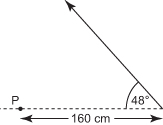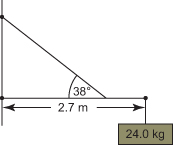 |
| 1 |  | 
A 53 N force has a west component of 45 N[W]. In what direction could the 53 N force be acting ? |
|  | A) | [S580W] |
|  | B) | [S320W] |
|  | C) | [N320W] |
|  | D) | [W500S] |
|
|
 |
| 2 |  | 
A crate of mass 38.0 kg sits on a board inclined at 28.00 to the horizontal. How much force will have to be applied directly down the board to start the crate moving, if the coefficient of static friction is 0.580? |
|  | A) | 15.9 N |
|  | B) | 191 N |
|  | C) | 175 N |
|  | D) | 18.7 N |
|
|
 |
| 3 |  | 
Two masses (46.0 kg and 63.0 kg ), connected by a cord running over a pulley, make up an Atwood machine. What is the acceleration of the masses? |
|  | A) | The 46.0 kg mass accelerates down at 1.53 m/s2 and the 63.0 kg mass accelerates up at 1.53 m/s2 |
|  | B) | The 46.0 kg mass accelerates up at 1.53 m/s2 and the 63.0 kg mass accelerates down at 1.53 m/s2. See p. 482 |
|  | C) | The 46.0 kg mass accelerates up at 13.4 m/s2 and the 63.0 kg mass accelerates down at 13.4 m/s2. See p. 482 |
|  | D) | The 46.0 kg mass accelerates up at 7.16 m/s2 and the 63.0 kg mass accelerates down at 7.16 m/s2. See p. 482 |
|
|
 |
| 4 |  | 
A 1.30 kg air puck, on a frictionless table, is connected to a 740.0 g mass by a cord passing over a pulley. If the mass is released and allowed to fall freely, what will be the speed of the air puck after it has traveled 96.0 cm? |
|  | A) | 3.27 m/s |
|  | B) | 6.84 m/s |
|  | C) | 2.61 m/s |
|  | D) | Zero. The 740 g mass cannot move the 1.3 kg puck. |
|
|
 |
| 5 |  | 
 <a onClick="window.open('/olcweb/cgi/pluginpop.cgi?it=jpg::::/sites/dl/free/0070922802/536439/pei_physics_Ch10_quiz2_question5.jpg','popWin', 'width=NaN,height=NaN,resizable,scrollbars');" href="#"><img valign="absmiddle" height="16" width="16" border="0" src="/olcweb/styles/shared/linkicons/image.gif"> (45.0K)</a>. Object m1 has a mass of 654g and m2 has a mass of 486 g. If the coefficient of kinetic friction is 0.220 what is the acceleration of m1? <a onClick="window.open('/olcweb/cgi/pluginpop.cgi?it=jpg::::/sites/dl/free/0070922802/536439/pei_physics_Ch10_quiz2_question5.jpg','popWin', 'width=NaN,height=NaN,resizable,scrollbars');" href="#"><img valign="absmiddle" height="16" width="16" border="0" src="/olcweb/styles/shared/linkicons/image.gif"> (45.0K)</a>. Object m1 has a mass of 654g and m2 has a mass of 486 g. If the coefficient of kinetic friction is 0.220 what is the acceleration of m1? |
|  | A) | 1.18 m/s2 down the incline |
|  | B) | 2.05 m/s2 up the incline |
|  | C) | 1.18 m/s2 up the incline |
|  | D) | Zero. The 486 g mass cannot move the 654 g mass. |
|
|
 |
| 6 |  | 
What is the torque of the applied force about the point P?  <a onClick="window.open('/olcweb/cgi/pluginpop.cgi?it=jpg::::/sites/dl/free/0070922802/536439/pei_physics_Ch10_quiz2_question6.jpg','popWin', 'width=NaN,height=NaN,resizable,scrollbars');" href="#"><img valign="absmiddle" height="16" width="16" border="0" src="/olcweb/styles/shared/linkicons/image.gif"> (41.0K)</a> <a onClick="window.open('/olcweb/cgi/pluginpop.cgi?it=jpg::::/sites/dl/free/0070922802/536439/pei_physics_Ch10_quiz2_question6.jpg','popWin', 'width=NaN,height=NaN,resizable,scrollbars');" href="#"><img valign="absmiddle" height="16" width="16" border="0" src="/olcweb/styles/shared/linkicons/image.gif"> (41.0K)</a> |
|  | A) | +3.1 J |
|  | B) | - 3.1 N.m |
|  | C) | +2.8 N.m |
|  | D) | 3.1 N.m |
|
|
 |
| 7 |  | 
 <a onClick="window.open('/olcweb/cgi/pluginpop.cgi?it=jpg::::/sites/dl/free/0070922802/536439/pei_physics_Ch10_quiz2_question7.jpg','popWin', 'width=NaN,height=NaN,resizable,scrollbars');" href="#"><img valign="absmiddle" height="16" width="16" border="0" src="/olcweb/styles/shared/linkicons/image.gif"> (42.0K)</a> shows a 24.0 kg object hanging from the end of a 6.80 kg uniform beam that is 2.70 m long and anchored to a vertical pole. What is the tension in the supporting cable that makes a 38.00 angle with the beam and is connected to the beam two thirds of the way down its length? <a onClick="window.open('/olcweb/cgi/pluginpop.cgi?it=jpg::::/sites/dl/free/0070922802/536439/pei_physics_Ch10_quiz2_question7.jpg','popWin', 'width=NaN,height=NaN,resizable,scrollbars');" href="#"><img valign="absmiddle" height="16" width="16" border="0" src="/olcweb/styles/shared/linkicons/image.gif"> (42.0K)</a> shows a 24.0 kg object hanging from the end of a 6.80 kg uniform beam that is 2.70 m long and anchored to a vertical pole. What is the tension in the supporting cable that makes a 38.00 angle with the beam and is connected to the beam two thirds of the way down its length? |
|  | A) | 574 N |
|  | B) | 67.5 N |
|  | C) | 448 N |
|  | D) | 655 N |
|
|
 |
| 8 |  | 
Which statement is true about momentum? |
|  | A) | Momentum is only conserved during elastic collisions? |
|  | B) | Momentum is only conserved during inelastic collisions |
|  | C) | Momentum is conserved in any collision |
|  | D) | Momentum is only conserved in one direction |
|
|
 |
| 9 |  | 
Which statement is true about kinetic energy? |
|  | A) | Kinetic energy is only conserved in one direction |
|  | B) | Kinetic energy is only conserved during inelastic collisions |
|  | C) | Kinetic energy is conserved in any collision |
|  | D) | Kinetic energy is only conserved during elastic collisions? |
|
|
 |
| 10 |  | 
A 36 g object exploded into three fragments. A 12 g fragment moved off at 36 m/s [N580E] and a 9.0 g fragment moved off at 48 m/s[W120N]. What was the velocity of the remaining fragment? |
|  | A) | 22 m/s[S100E] |
|  | B) | 22 m/s[N100W] |
|  | C) | 29 m/s [S150E] |
|  | D) | 19 m/s [S140W] |
|
|

